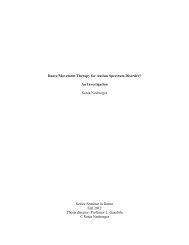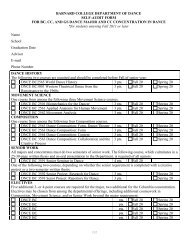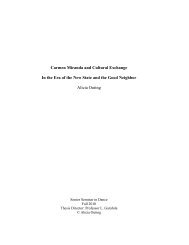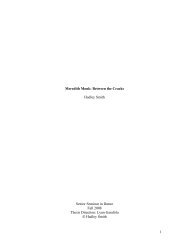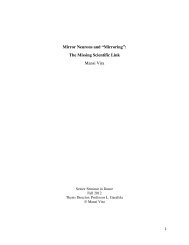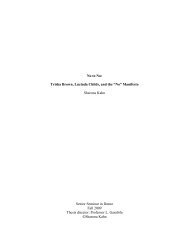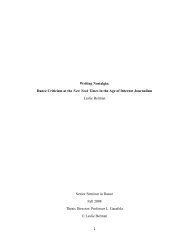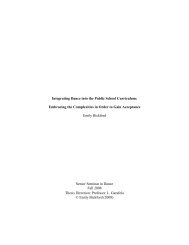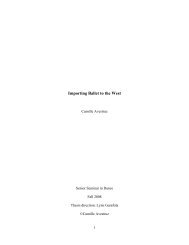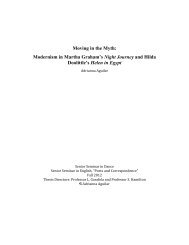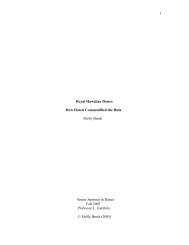Senior Thesis: 5-6 Pages - Dance - Barnard College
Senior Thesis: 5-6 Pages - Dance - Barnard College
Senior Thesis: 5-6 Pages - Dance - Barnard College
You also want an ePaper? Increase the reach of your titles
YUMPU automatically turns print PDFs into web optimized ePapers that Google loves.
modern dance that emphasized the torso movements of the primitive ritual of Caribbean-African<br />
dance and jazz rhythms.” 11<br />
8<br />
While the Dunham technique broke the minstrelsy conventions that limited performing<br />
arts opportunities for African-Americans, the popularity of Dunham’s work crystallized the<br />
notion that blacks were capable of only learning and performing “primitive” dance. For<br />
example, in a 1944 promotional advertisement for Dunham’s Tropical Revue words such as<br />
“heatwave”, “voodoo”, and “primitive” are used to describe the show. 12 The acceptance of<br />
Dunham’s work and technique rested on the exotic appeal of her movement and dancers.<br />
Although Dunham created a style that showcased the talent of black dancers, they were still not<br />
considered to be on the same level as white dancers.<br />
During the 1960s many blacks embraced an aesthetic of artistic and political<br />
empowerment, following the end of legal segregation. “Black Art is the aesthetic and spiritual<br />
sister of the Black Power concept. As such, it envisions an art that speaks directly to the needs<br />
and aspirations of Black America. In order to perform this task, the Black Arts Movement<br />
proposes a radical reordering of the western cultural aesthetic.” 13 As defined by Annemarie<br />
Bean, the new black aesthetic heightened the clash between the “classical” art of ballet and the<br />
“primitive” or exotic style of black dance, exemplified by Dunham. This new expression of<br />
African-Americans conflicted with the notion that black dancers were capable of performing<br />
ballet.<br />
This was complicated by the history of ballet in America. “Until 1940,” critic Anita<br />
Finkel has written, “there was virtually no American tradition of ballet, and it was Ballet Theatre<br />
11 Kaiso! : Writings By and About Katherine Dunham, d. . Clark and Sara E. Johnson.<br />
(Madison: University of Wisconsin Press, 2005), 179.<br />
12 Kaiso!, Figure 11<br />
13 Annemarie Bean ed., A Sourcebook on African-American Performance : Plays, People, Movements,<br />
(New York: Routledge, 1999), 55.




